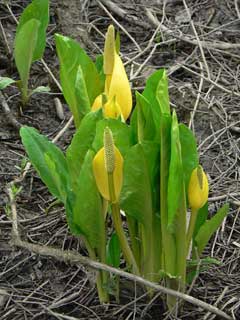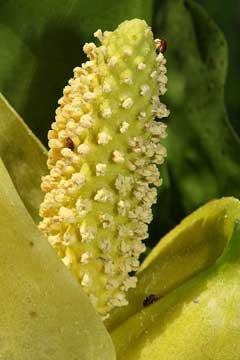 |
|
http://commons.wikimedia.org/wiki/User:Wsiegmund |
 |
| http://commons.wikimedia.org/wiki/User:Wsiegmund |
Translate this page:
Summary
Physical Characteristics

 Lysichiton americanus is a PERENNIAL growing to 1 m (3ft 3in) by 0.8 m (2ft 7in) at a slow rate.
Lysichiton americanus is a PERENNIAL growing to 1 m (3ft 3in) by 0.8 m (2ft 7in) at a slow rate.
See above for USDA hardiness. It is hardy to UK zone 6. It is in flower in April, and the seeds ripen from June to July. The species is hermaphrodite (has both male and female organs) and is pollinated by Insects.
Suitable for: light (sandy), medium (loamy) and heavy (clay) soils. Suitable pH: mildly acid, neutral and basic (mildly alkaline) soils. It can grow in semi-shade (light woodland) or no shade. It prefers wet soil and can grow in water.
UK Hardiness Map
US Hardiness Map
Synonyms
Plant Habitats
Woodland Garden Dappled Shade; Shady Edge; Ground Cover; Pond; Bog Garden;
Edible Uses
Edible Parts: Leaves Root Shoots
Edible Uses:
Young shoots - these must be thoroughly cooked otherwise they are poisonous[172]. The native North American Indian tribes would cook them in several changes of water, the end result being a tasteless mush[172]. The leaves can be dried then powdered and used as a thickening agent[256]. Older leaves have been used to wrap up food that was being baked. The leaves would impart a pleasant flavouring to the food[257]. Young flower stalks - cooked[256]. Only used when there was a shortage of other foods, the stalks must be thoroughly cooked or else they are poisonous[256]. It is said that no more than three stalks should be consumed at one meal[257]. Root - cooked. It must be thoroughly cooked or dried before use, otherwise it is poisonous[61, 105, 118, 207]. Rich in starch, a flour can be made from the dried and ground root[212]. The root has a hot flavour, somewhat like ginger[256]. The root is best harvested in the autumn[256].
References More on Edible Uses
Medicinal Uses
Plants For A Future can not take any responsibility for any adverse effects from the use of plants. Always seek advice from a professional before using a plant medicinally.
Antispasmodic Blood purifier Poultice Styptic
Antispasmodic, styptic[61, 172]. Yellow skunk cabbage was employed medicinally by several native North American Indian tribes who used it mainly as a poultice to treat a variety of complaints[257]. It is little, if at all, used in modern herbalism. Caution is advised, especially if using the plant internally, see the notes above on toxicity. A poultice of roots has been applied to swellings, sores, boils, burns and rheumatic joints[257]. A poultice of the heated blossoms has been applied to rheumatic joints[257]. A poultice of the leaves has been applied to scrofulous sores, burns, cuts, swellings and chest pains[257]. Heated leaves have been applied tot he body in order to draw out splinters and thorns[257]. The leaves have also been used as a general tonic in a herbal sweat bath[257]. The raw root has been chewed by women in order to secure an abortion[257]. A decoction of the root has been drunk as a blood purifier[257].
References More on Medicinal Uses
The Bookshop: Edible Plant Books
Our Latest books on Perennial Plants For Food Forests and Permaculture Gardens in paperback or digital formats.

Edible Tropical Plants
Food Forest Plants for Hotter Conditions: 250+ Plants For Tropical Food Forests & Permaculture Gardens.
More

Edible Temperate Plants
Plants for Your Food Forest: 500 Plants for Temperate Food Forests & Permaculture Gardens.
More

More Books
PFAF have eight books available in paperback and digital formats. Browse the shop for more information.
Shop Now
Other Uses
Containers Lining Waxed paper
The leaves are large and water repellent, they can be used as a 'waxed paper' and also for lining fruit baskets etc and for wrapping food in for baking[99, 256]. They were also folded and used as containers for collecting berries, as drinking cups and as a covering or mat for food that was being dried[257]. The plants have very large leaves and form a slowly spreading clump. They can be grown as a ground cover, spaced about 1 metre apart each way[208].
Special Uses
Ground cover Scented Plants
References More on Other Uses
Cultivation details
Requires a wet or damp humus-rich soil in full sun or semi-shade[200]. Plants often do not flower when grown in the shade[99]. Grows well by water or in the bog garden[1]. Succeeds in shallow water and also in still or flowing water[188]. Hardy to at least -15°c[200]. Young plants require protection from slugs[187]. Plants are slow to establish at first, taking some years, but can then become naturalized and often self-sow[200]. The flowers have an unpleasant aroma[187] which is rather like a combination of skunk, carrion and garlic[245]. This smell attracts flies and midges in great numbers to pollinate the flowers and so spiders tend to like making their webs in the plant so they can catch lots of food[245]. Hybridizes with L. camtschatcense[200].
References Carbon Farming Information and Carbon Sequestration Information
Temperature Converter
Type a value in the Celsius field to convert the value to Fahrenheit:
Fahrenheit:
The PFAF Bookshop
Plants For A Future have a number of books available in paperback and digital form. Book titles include Edible Plants, Edible Perennials, Edible Trees,Edible Shrubs, Woodland Gardening, and Temperate Food Forest Plants. Our new book is Food Forest Plants For Hotter Conditions (Tropical and Sub-Tropical).
Shop Now
Plant Propagation
The seed is best sown as soon as it is ripe in pots in a cold frame[134]. Keep very moist, preferably by emmersing the pot in 2 -3 cm of water[200]. Germination is usually good, taking place within 1 - 2 months at 15°c[134]. When they are large enough to handle, prick the seedlings out into individual pots and grow them on in trays of water in the greenhouse for at least their first winter. Plant them out into their permanent positions in late spring or early summer, after the last expected frosts. Division in the middle of autumn or mid to late winter, but no later than this because the plant will be coming into growth.
Other Names
If available other names are mentioned here
Native Range
NORTHERN AMERICA: United States (Alaska (south), Idaho, Montana (west), Oregon, Washington, California (northwest)), Canada (British Columbia)
Weed Potential
Right plant wrong place. We are currently updating this section.
Please note that a plant may be invasive in one area but may not in your area so it's worth checking.
Conservation Status
IUCN Red List of Threatened Plants Status :

Growth: S = slow M = medium F = fast. Soil: L = light (sandy) M = medium H = heavy (clay). pH: A = acid N = neutral B = basic (alkaline). Shade: F = full shade S = semi-shade N = no shade. Moisture: D = dry M = Moist We = wet Wa = water.
Now available:
Food Forest Plants for Mediterranean Conditions
350+ Perennial Plants For Mediterranean and Drier Food Forests and Permaculture Gardens.
[Paperback and eBook]
This is the third in Plants For A Future's series of plant guides for food forests tailored to
specific climate zones. Following volumes on temperate and tropical ecosystems, this book focuses
on species suited to Mediterranean conditions—regions with hot, dry summers and cool, wet winters,
often facing the added challenge of climate change.
Read More
Expert comment
Author
Hult.&St.John
Botanical References
71200
Links / References
For a list of references used on this page please go here
Readers comment